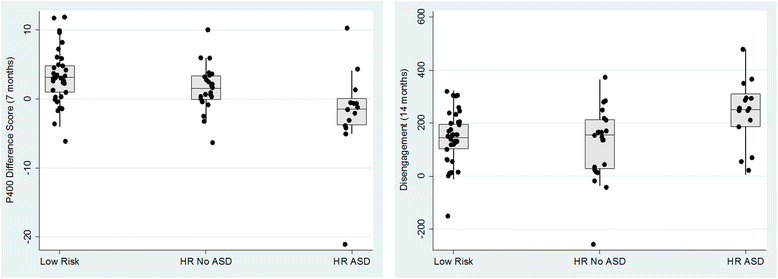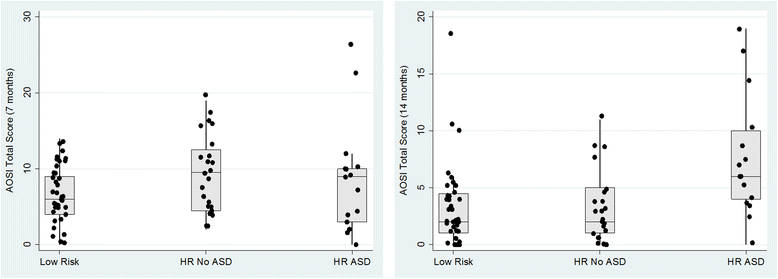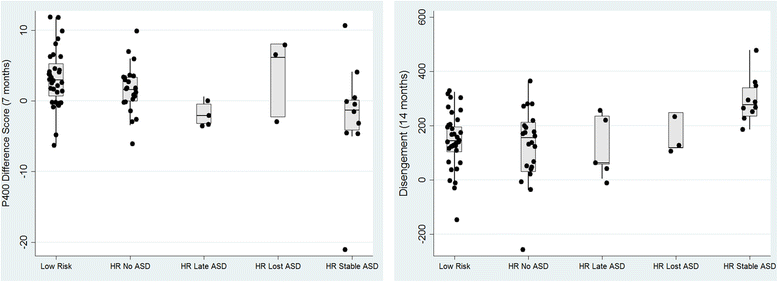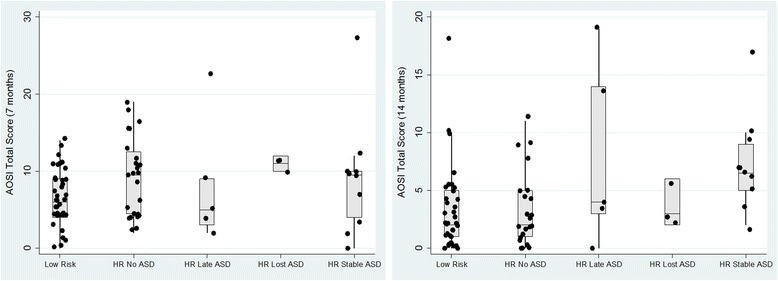Neurocognitive and observational markers: prediction of autism spectrum disorder from infancy to mid-childhood
- PMID: 29018511
- PMCID: PMC5610446
- DOI: 10.1186/s13229-017-0167-3
Neurocognitive and observational markers: prediction of autism spectrum disorder from infancy to mid-childhood
Abstract
Background: Prospective studies of infants at high familial risk for autism spectrum disorder (ASD) have identified a number of putative early markers that are associated with ASD outcome at 3 years of age. However, some diagnostic changes occur between toddlerhood and mid-childhood, which raises the question of whether infant markers remain associated with diagnosis into mid-childhood.
Methods: First, we tested whether infant neurocognitive markers (7-month neural response to eye gaze shifts and 14-month visual disengagement latencies) as well as an observational marker of emerging ASD behaviours (the Autism Observation Scale for Infants; AOSI) predicted ASD outcome in high-risk (HR) 7-year-olds with and without an ASD diagnosis (HR-ASD and HR-No ASD) and low risk (LR) controls. Second, we tested whether the neurocognitive markers offer predictive power over and above the AOSI.
Results: Both neurocognitive markers distinguished children with an ASD diagnosis at 7 years of age from those in the HR-No ASD and LR groups. Exploratory analysis suggested that neurocognitive markers may further differentiate stable versus lost/late diagnosis across the 3 to 7 year period, which will need to be tested in larger samples. At both 7 and 14 months, combining the neurocognitive marker with the AOSI offered a significantly improved model fit over the AOSI alone.
Conclusions: Infant neurocognitive markers relate to ASD in mid-childhood, improving predictive power over and above an early observational marker. The findings have implications for understanding the neurodevelopmental mechanisms that lead from risk to disorder and for identification of potential targets of pre-emptive intervention.
Keywords: Autism; Diagnosis; High risk; Infants; Neurocognitive; Prediction; Siblings.
Conflict of interest statement
Ethics approval and consent to participate
Ethical approval was obtained from the NHS National Research Ethics Service (NHS RES London REC 08/H0718/76; 14/LO/0170). Parents provided written informed consent.
Consent for publication
Not applicable
Competing interests
The authors declare that they have no competing interests.
Publisher’s Note
Springer Nature remains neutral with regard to jurisdictional claims in published maps and institutional affiliations.
Figures




References
-
- American Psychiatric Association . Diagnostic and statistical manual of mental disorders (DSM-5) Washington DC: American Psychiatric Association; 2013.
Publication types
MeSH terms
Substances
Grants and funding
LinkOut - more resources
Full Text Sources
Other Literature Sources
Medical

